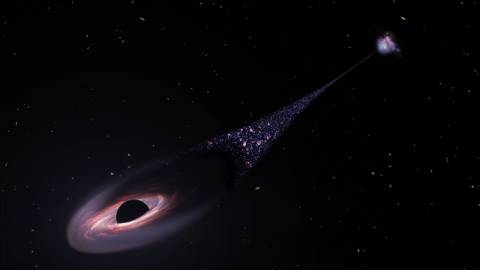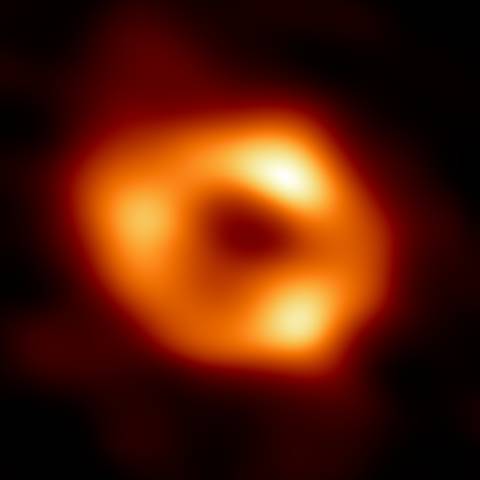Astronomers think they have discovered a supermassive black hole traveling away from its home galaxy at 4 million mph — so fast it's not doing what it's notorious for: sucking light out of the universe.

Quite the opposite, possibly. Rather than ripping stars to shreds and swallowing up every morsel, this black hole is believed to be fostering new star formation, leaving a trail of newborn stars stretching 200,000 light-years through space. Pieter van Dokkum, an astronomy professor at Yale University, said as the black hole rams into gas, it seems to trigger a narrow corridor of new stars, where the gas has a chance to cool.

How exactly it works, though, isn't known, said van Dokkum, who led research on the phenomenon captured by NASA's Hubble Space Telescope accidentally. A paper on the findings was published last week in The Astrophysical Journal Letters.
“What we’re seeing is the aftermath, he said in a statement. Like the wake behind a ship, we’re seeing the wake behind the black hole.”
SEE ALSO: Black holes, rankedBlack holes are some of the most elusive things in outer space. The most common kind, a stellar black hole, is often thought to be the result of an enormous star dying in a supernova explosion. The star's material then collapses onto itself, condensing into a relatively tiny area.
But how supermassive black holes, millions to billions of times more massive than the sun, form is even more mysterious. Many astrophysicists and cosmologists believe these behemoths lurk at the center of virtually all galaxies. Recent Hubble Space Telescope observations have bolstered the theory that supermassive black holes get their start in the dusty cores of starburst galaxies, where new stars are rapidly churned out, but scientists are still trying to get to the bottom of it.
Want more science and tech news delivered straight to your inbox? Sign up for Mashable's Top Stories newsletter today.
Like the wake behind a ship, we’re seeing the wake behind the black hole.”Black holes don't have surfaces, like on a planet or star. Instead, they have a boundary called an event horizon—it's a point of no return. Generally, if anything swoops too close, it will fall in, never to escape the hole's gravitational pull. But this weird black hole may be moving too fast to consume celestial objects as usual, defying the status quo.
Sagittarius A* is the supermassive black hole found in the center of the Milky Way galaxy. Credit: Event Horizon TelescopeThe research team has suggested a possible theory: Maybe the runaway black hole is the result of a chain of events caused by three colliding supermassive black holes. One could have been stealing momentum from the other two and gotten ejected out of its host galaxy, while the other two shot off in the other direction. Evidence that might support this idea is that there is no sign of an active black hole remaining at the galaxy's core.
Van Dokkum was looking for star clusters in a nearby galaxy when he noticed what appeared to be a little streak in his Hubble image. At first, he thought it was a cosmic ray causing an artifact in the photo. After further analysis at the Keck Observatory in Hawaii, he and his team predicted it must be a train of young blue stars. The trail is almost half as bright as the host galaxy, indicating it is a hotbed of stellar action.
The scientists plan to confirm the black hole explanation with follow-up observations using the James Webb Space Telescope and the Chandra X-ray Observatory.
